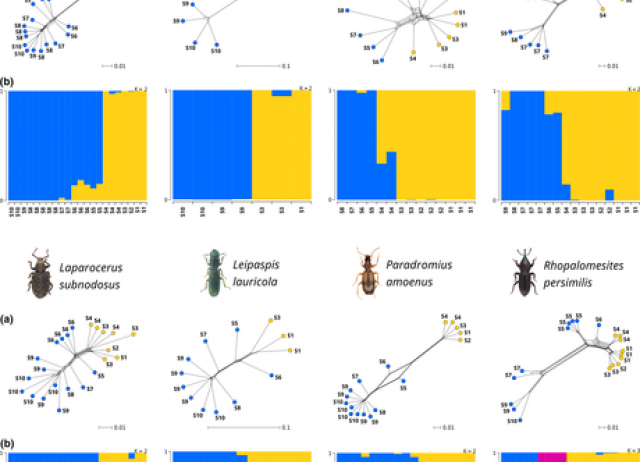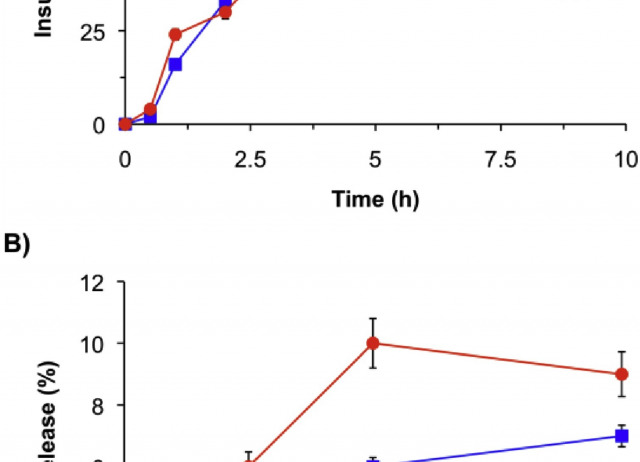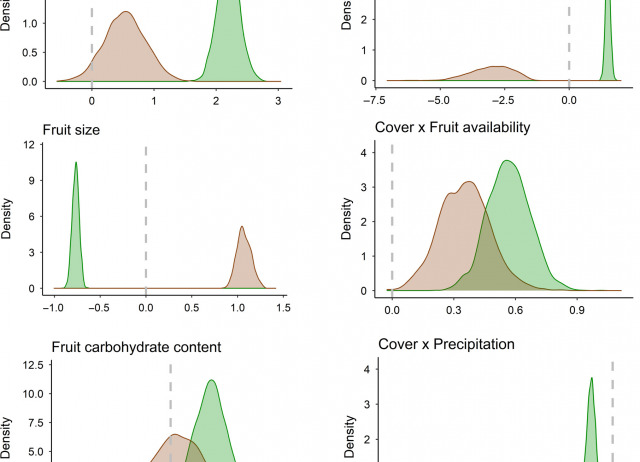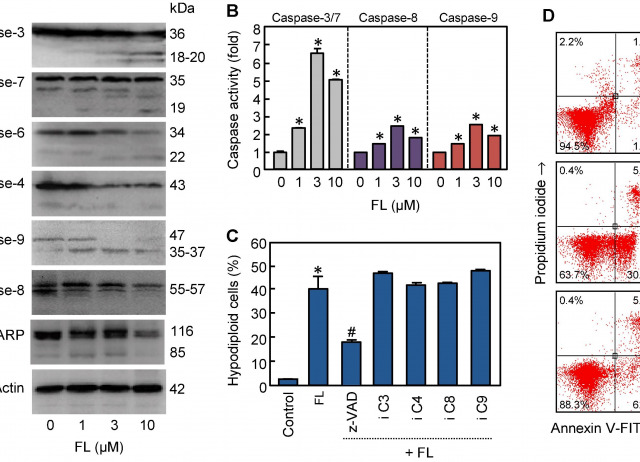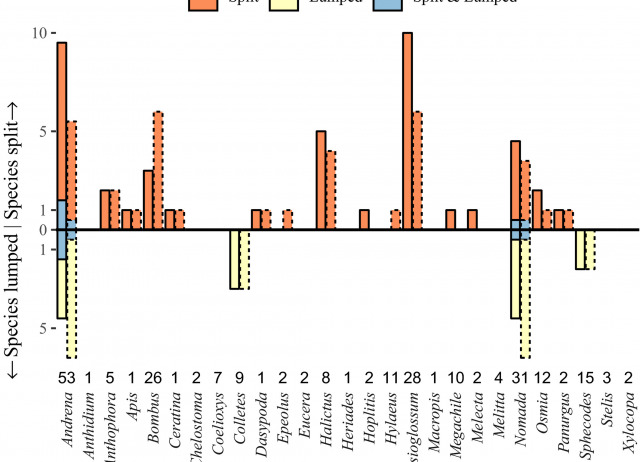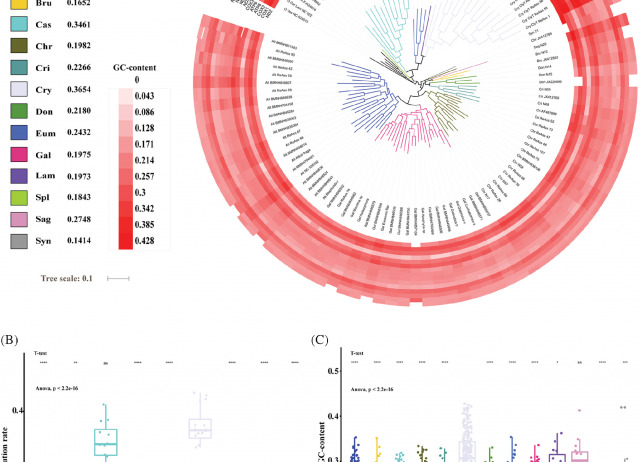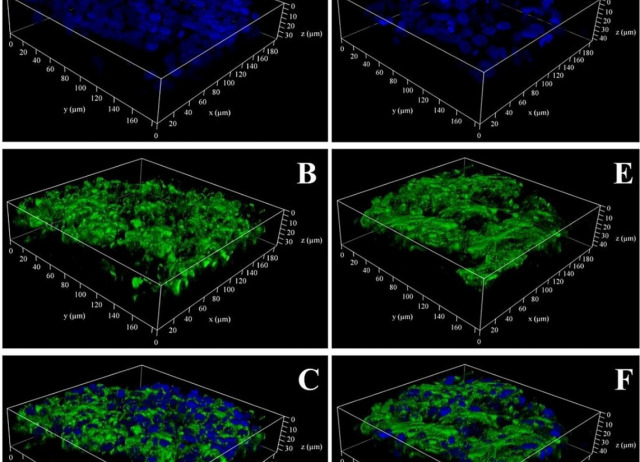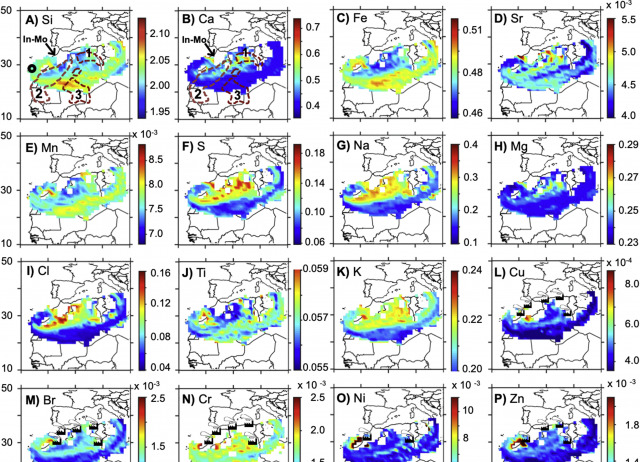
Rapid changes of dust geochemistry in the Saharan Air Layer linked to sources and meteorology
Based at Izaña Observatory (~2400 m a.s.l. in Tenerife), we performed 1-h resolution measurements of elemental composition of dust in the Saharan Air Layer (SAL) and studied the variability of the ratios of these elements to aluminium (elemental ratios). In a period (~1 week) of continuous dust presence (50–200 μg/m3), we observed rapid variations of dust composition; some elemental ratios changed by a factor 2 in a few (5–8) hours. The lowest variability (Normalized Variability Range, %) was found for Si/Al (9%) and Fe/Al (9%), followed by the ratios of K, Ti, Mg, Mn, Ca and Sr to Al (20–80%), and the highest for S/Al, Na/Al and Cl/Al (110–160%) and a number of trace metals (Cr, Cu, Ni, Zn, Zr) and Br (>200%). This variability was induced by the alternating impacts of three of the large North African dust sources: NE Algeria (rich in evaporite minerals bearing Ca, S, Sr, K and Mg and in illite mineral), Western Sahara to Bechar region (containing Na, S and Cl rich Yermosol soils) and SW Sahara – Western Sahel (rich in illite and hematite). We traced the variability in large-scale meteorology using the so-called North African Dipole Intensity (NAFDI: strength of the subtropical Saharan high -Morocco-to the monsoon tropical low -Nigeria-). The mobilization of dust from the different sources was associated with westward propagating Harmattan pulses linked to the change of phase of NAFDI (- to +), the associated westward shifts of the Saharan Heat Low and convective monsoon inflow. We found a correlation between dust composition in the SAL and NAFDI: moderate NAFDI values (0 to +2.5) were associated with Ca, K, Na, Mg and S rich dust linked to dust sources in NE Algeria, whereas higher NAFDI values (+2.5 to +4) were linked to Fe rich dust (Ca, Na and S depleted) linked to dust sources in SW Sahara – Western Sahel. The results of this study also show that some trace elements (Br, Cr, Ni, Zn and Zr) are influenced by industrial emissions into North Africa.
Rodríguez, Sergio; Calzola, Giulia; Chiari, Massimo; Nava, Silvia; Isabel García, M.; López-Solano, Javier; Marrero, Carlos; López-Darias, Jessica; Cuevas, Emilio; Alonso-Pérez, Silvia; Prats, Natalia; Amato, Fulvio ; Lucarelli, Franco; Querol, Xavier
Climate drives community-wide divergence within species over a limited spatial scale: evidence from an oceanic island
Geographic isolation substantially contributes to species endemism on oceanic islands when speciation involves the colonisation of a new island. However, less is understood about the drivers of speciation within islands. What is lacking is a general understanding of the geographic scale of gene flow limitation within islands, and thus the spatial scale and drivers of geographical speciation within insular contexts. Using a community of beetle species, we show that when dispersal ability and climate tolerance are restricted, microclimatic variation over distances of only a few kilometres can maintain strong geographic isolation extending back several millions of years. Further to this, we demonstrate congruent diversification with gene flow across species, mediated by Quaternary climate oscillations that have facilitated a dynamic of isolation and secondary contact. The unprecedented scale of parallel species responses to a common environmental driver for evolutionary change has profound consequences for understanding past and future species responses to climate variation.
Salces-Castellano, Antonia; Patiño, Jairo; Alvarez, Nadir; Andújar, Carmelo; Arribas, Paula; Braojos-Ruiz, Juan José; del Arco-Aguilar, Marcelino; García-Olivares, Víctor; Karger, Dirk N.; López, Heriberto; Manolopoulou, Ioanna; Oromí, Pedro; Pérez-Delgado, Antonio J.; Peterman, William E.; Rijsdijk, Kenneth F.; Emerson, Brent C.
Insulin-loaded mucoadhesive nanoparticles based on mucin-chitosan complexes for oral delivery and diabetes treatment
In this study, insulin-loaded nanoparticles (NPs) were prepared via self-gelation method using chitosan and aqueous soluble snail mucin as natural polymers. Herein, mucins were ionically interacted with chitosan at different concentrations to obtained insulin-loaded NPs, labelled as A1 (1:1) (i.e., chitosan 2 % w/v + mucin 2 % w/v) and A2 (2:1) (chitosan 4 % w/v + mucin 2 % w/v), using poloxamer and poly vinyl alcohol as solid surfactant. Such formulation was selected to provide the necessary dynamics for the formation of the nanoparticles while maintaining the surface properties that will favor the encapsulation of insulin. Each system was characterized in terms of their particle size distribution, morphology, zeta potential, and polydispersity index. In vitro release of insulin was evaluated in acidic solution (pH 1.2) and phosphate buffer solution (pH 7.4), and the hypoglycaemic activity was evaluated in diabetes rats. The prepared insulin-loaded NPs displayed particles with relatively smooth surfaces and an average particle size of 479.6 and 504.1 nm for A1 and A2, respectively. Zeta potential and polydispersity index, ranged from 22.1 to 31.2 mV and 0.155–0.185, respectively. The encapsulating efficiency for the systems A1 and A2 were 88.6 and 92.5, respectively, and a self-sustained release of encapsulated insulin was observed for over a period of 8 h. In vivo studies revealed a pronounced hypoglycaemic effect in diabetic rats after peroral administration of the insulin-loaded NPs compared to the effect caused by free oral insulin solution. In addition, both the pharmacokinetic and toxicity results showed low plasma clearance of insulin and no signs of toxicity on the liver enzyme and cell viability, which suggested good biocompatibility of the NPs formulations. Overall, the formation of NPs of insulin with chitosan and snail mucin represents a potentially safe and promising approach to protect insulin and enhance its peroral delivery.
Mumuni, Momoh A.; Kenechukwu, Franklin C.; Ofokansi, Kenneth C.; Attama, Anthony A.; Díaz Díaz, David
Behavioural complementarity among frugivorous birds and lizards can promote plant diversity in island ecosystems
The behavioural complementarity of fruit-eating animals is thought to exert a key role in plant community assembly. However, a mechanistic understanding of the causal links between the two processes is still lacking. This study assesses whether complementarity between dispersers in feeding and microhabitat-use behaviour enhances community-scale dispersal services, resulting in a more diverse community of seedlings. We used a Bayesian approach to connect a comprehensive database of seed dispersal effectiveness at a community scale with a transition probability model that accounts for behavioural complementarity. Our model system was the thermosclerophyllous shrubland of the Canary Islands. There, fleshy-fruited plants rely on two types of frugivores: lizards and birds. Lizards consumed all plant species and preferentially used open areas, whereas birds foraged for small single-seeded fruits and dispersed their seeds beneath plants. Through feeding on different sets of plants, they generated a rich seed-rain community. By diversifying the microhabitat of deposition, more species could find suitable recruitment sites. Distinct foraging and microhabitat-use choices led to complementary dispersal services. Lizards ensured that all plant species were present in the seedling community, while birds promoted a more even distribution of them. As a result, diversity in the community of seedlings was enhanced. Overall, our work underscores that behavioural complementarity promotes diversity in the early-regenerating plant communities. These enhanced dispersal services rely on the presence of all functional groups. Thus, in communities where frugivores display unique behaviours, preserving a diverse community of dispersers should be a conservation target. A free Plain Language Summary can be found within the Supporting Information of this article.
Morán-López, Teresa; González-Castro, Aarón; Morales, Juan Manuel; Nogales, Manuel
The synthetic flavanone 6-methoxy-2-(naphthalen-1-yl)chroman-4-one induces apoptosis and activation of the MAPK pathway in human U-937 leukaemia cells
Synthetic flavonoids containing a naphthalene ring have attracted attention as potential cytotoxic compounds. Here, we synthesized ten chalcones and their corresponding flavanones and evaluated their antiproliferative activity against the human tumour cell line U-937. This series of chalcone derivatives was characterized by the presence of a naphthalene ring which was kept unaltered- and attached to the β carbon of the 1-phenyl-2-propen-1-one framework. The structure-activity relationship of these chalcone derivatives and their corresponding cyclic compounds was investigated by the introduction of different substituents (methyl, methoxy, benzyloxy, chlorine) or by varying the position of the methoxy or benzyloxy groups on the A ring. The results revealed that both the chalcone containing the methoxy group at 5′ position of the A ring as well as its corresponding flavanone [6-methoxy-2-(naphthalen-1-yl)chroman-4-one] were the most cytotoxic compounds, with IC50 values of 2.8 ± 0.2 and 1.3 ± 0.2 μM, respectively, against U-937 cells. This synthetic flavanone was as cytotoxic as the antitumor etoposide in U-937 cells and displayed strong cytotoxicity against additional human leukaemia cell lines, including HL-60, MOLT-3 and NALM-6. Human peripheral blood mononuclear cells were more resistant than leukaemia cells to the cytotoxic effects of the flavanone. Treatment of U-937 cells with this compound induced G2-M cell cycle arrest, an increase in sub-G1 ratio and annexin-V positive cells, mitochondrial cytochrome c release, caspase activation and poly(ADP-ribose)polymerase processing. Apoptosis induction triggered by this flavonoid was blocked by overexpression of the anti-apoptotic protein Bcl-2. This flavanone induces phosphorylation of p38 mitogen-activated protein kinases, extracellular-signal regulated kinases and c-jun N-terminal kinases/stress-activated protein kinases (JNK/SAPK) following different kinetics. Moreover, cell death was attenuated by the inhibition of mitogen-activated extracellular kinases and JNK/SAPK and was independent of reactive oxygen species generation.
Saavedra, Ester; Del Rosario, Henoc; Brouard, Ignacio; Hernández-Garcés, Judith; García, Celina; Quintana, José; Estévez, Francisco
Impacts of Desert Dust Outbreaks on Air Quality in Urban Areas
Air pollution has many adverse effects on health and is associated with an increased risk of mortality. Desert dust outbreaks contribute directly to air pollution by increasing particulate matter concentrations. We investigated the influence of desert dust outbreaks on air quality in Santa Cruz de Tenerife, a city located in the dust export pathway off the west coast of North Africa, using air-quality observations from a six-year period (2012–2017). During winter intense dust outbreaks PM 10 mean (24-h) concentrations increased from 14 μ g m −3 to 98 μ g m −3 , on average, and PM 2.5 mean (24-h) concentrations increased from 6 μ g m −3 to 32 μ g m −3 . Increases were less during summer outbreaks, with a tripling of PM 10 and PM 2.5 daily mean concentrations. We found that desert dust outbreaks reduced the height of the marine boundary layer in our study area by >45%, on average, in summer and by ∼25%, on average, in winter. This thinning of the marine boundary layer was associated with an increase of local anthropogenic pollution during dust outbreaks. NO 2 and NO mean concentrations more than doubled and even larger relative increases in black carbon were observed during the more intense summer dust outbreaks; increases also occurred during the winter outbreaks but were less than in summer. This has public health implications; local anthropogenic emissions need to be reduced even further in areas that are impacted by desert dust outbreaks to reduce adverse health effects.
Milford, C.; Cuevas, E.; Marrero, Carlos L.; Bustos, J. J.; Gallo, Víctor; Rodríguez, Sergio; Romero-Camos, Pedro M.; Torres, Carlo
A validated workflow for rapid taxonomic assignment and monitoring of a national fauna of bees (Apiformes) using high throughput DNA barcoding
Improved taxonomic methods are needed to quantify declining populations of insect pollinators. This study devises a high-throughput DNA barcoding protocol for a regional fauna (United Kingdom) of bees (Apiformes), consisting of reference library construction, a proof-of-concept monitoring scheme, and the deep barcoding of individuals to assess potential artefacts and organismal associations. A reference database of cytochrome oxidase c subunit 1 (cox1) sequences including 92.4% of 278 bee species known from the UK showed high congruence with morphological taxon concepts, but molecular species delimitations resulted in numerous split and (fewer) lumped entities within the Linnaean species. Double tagging permitted deep Illumina sequencing of 762 separate individuals of bees from a UK-wide survey. Extracting the target barcode from the amplicon mix required a new protocol employing read abundance and phylogenetic position, which revealed 180 molecular entities of Apiformes identifiable to species. An additional 72 entities were ascribed to nuclear pseudogenes based on patterns of read abundance and phylogenetic relatedness to the reference set. Clustering of reads revealed a range of secondary operational taxonomic units (OTUs) in almost all samples, resulting from traces of insect species caught in the same traps, organisms associated with the insects including a known mite parasite of bees, and the common detection of human DNA, besides evidence for low-level cross-contamination in pan traps and laboratory procedures. Custom scripts were generated to conduct critical steps of the bioinformatics protocol. The resources built here will greatly aid DNA-based monitoring to inform management and conservation policies for the protection of pollinators.
Creedy, Thomas J.; Norman, Hannah; Tang, Cuong Q.; Qing Chin, Kai; Andujar, Carmelo; Arribas, Paula; O'Connor, Rory S.; Carvell, Claire; Notton, David G.; Vogler, Alfred P.
Characterization of Chemical Compounds and Antioxidant Activity of Centaurea solstitialis sp. schouwii (DC.) Q. et S. (Asteraceae)
Background: The antioxidant activity and the total phenolic and flavonoid contents of the derived extracts (chloroform, ethyl acetate and n-butanol) of the 70% hydroalcoholic extract of the aerial parts of Centaurea solstitialis growing in Algeria was assessed. The active extracts were selected for phytochemical investigations.
Methods: The antioxidant capabilities of the extracts were assessed using 1, 1-diphenyl-2- picrylhydrazyl radical (DPPH•) scavenging and Cupric Ion Reducing Antioxidant Capacity (CUPRAC) assays. Butylhydroxyanisole (BHA), butylhydroxytoluene (BHT) and α –tocopherol were used as positive controls. The total phenolic content and total flavonoid content of the extracts were determined as gallic acid equivalents and quercetin equivalents, respectively. Chromatographic methods were used to isolate the secondary metabolites and spectrometric and spectroscopic methods were used to determine their chemical structures.
Results: The ethyl acetate extract exhibited the highest antioxidant activities followed by the n-butanol extract. The highest phenolic and flavonoid contents were found in the n-butanol extract. Phytochemical study of the ethyl acetate and n-butanol extracts led to the isolation of an undescribed guaianolide named 3-(4-hydroxybenzoyl)-cynaratriol and a known sesquiterpene lactone along with three known flavonoid glycosides. Their structures were established by spectral analyzes mainly high resolution electrospray ionisation mass spectrometry (HR-ESIMS) and 1D and 2D nuclear magnetic resonance experiments.
Conclusion: The extracts of aerial parts of C. solstitialis showed significant antioxidant activities. An undescribed sesquiterpene lactone and four known secondary metabolites were isolated from the most active extracts.
Aliouche, Lamia; Mosset, Paul; León, Francisco; Brouard, Ignacio; Benayache, Samir; Djamel, Sarri; Benayache, Fadila
The phylogeny of leaf beetles (Chrysomelidae) inferred from mitochondrial genomes
The high-level classification of Chrysomelidae (leaf beetles) currently recognizes 12 or 13 well-established subfamilies, but the phylogenetic relationships among them remain ambiguous. Full mitochondrial genomes were newly generated for 27 taxa and combined with existing GenBank data to provide a dataset of 108 mitochondrial genomes covering all subfamilies. Phylogenetic analysis under maximum likelihood and Bayesian inference recovered the monophyly of all subfamilies, except that Timarcha was split from Chrysomelinae in some analyses. Three previously recognized major clades of Chrysomelidae were broadly supported: the ‘chrysomeline’ clade consisting of (Chrysomelinae (Galerucinae + Alticinae)); the ‘sagrine’ clade with internal relationships of ((Bruchinae + Sagrinae) + (Criocerinae + Donaciinae)), and the ‘eumolpine’ clade comprising (Spilopyrinae (Cassidinae (Eumolpinae (Cryptocephalinae + Lamprosomatinae)))). Relationships among these clades differed between data treatments and phylogenetic algorithms, and were complicated by two additional deep lineages, Timarcha and Synetinae. Various topological tests favoured the PhyloBayes software as the preferred inference method, resulting in the arrangement of (chrysomelines (eumolpines + sagrines)), with Timarcha placed as sister to the chrysomeline clade and Synetinae as a deep lineage splitting near the base. Whereas mitogenomes provide a solid framework for the phylogeny of Chrysomelidae, the basal relationships do not agree with the topology of existing molecular studies and remain one of the most difficult problems of Chrysomelidae phylogenetics.
Nie, Rui-e; Andújar, Carmelo ; Gómez-Rodríguez, Carola ; Bai, Ming; Xue, Huai-Jun; Tang, Min; Yang, Chen-Tao.; Tang, Pu; Yang, Xing-Ke; Vogler, Alfried P.
Biopolymer/Glycopolypeptide-Blended Scaffolds: Synthesis, Characterization and Cellular Interactions
Three-dimensional (3D) scaffolds formed from natural biopolymers gelatin and chitosan that are chemically modified by galactose have shown improved hepatocyte adhesion, spheroid geometry and functions of the hepatocytes. Galactose specifically binds to the hepatocytes via the asialoglycoprotein receptor (ASGPR) and an increase in galactose density further improves the hepatocyte proliferation and functions. In this work, we aimed to increase the galactose density within the biopolymeric scaffold by physically blending the biopolymers chitosan and gelatin with an amphiphlic β-galactose polypeptide (PPO-GP). PPO-GP, is a di-block copolymer with PPO and β-galactose polypeptide, exhibits lower critical solution temperature and is entrapped within the scaffold through hydrophobic interactions. The uniform distribution of PPO-GP within the scaffold was confirmed by fluorescence microscopy. SEM and mechanical testing of the hybrid scaffolds indicated pore size, inter connectivity and compression modulus similar to the scaffolds made from 100 % biopolymer. The presence of the PPO-GP on the surface of the scaffold was tested monitoring the interaction of an analogous mannose containing PPO-GP scaffold and the mannose binding lectin Con-A. In vitro cell culture experiments with HepG2 cells were performed on GLN-GP and CTS-GP and their cellular response was compared with GLN and CTS scaffolds for a period of seven days. Within three days of culture the Hep G2 cells formed multicellular spheroids on GLN-GP and CTS-GP more efficiently than on the GLN and CTS scaffolds. The multicellular spheroids were also found to infiltrate more in GLN-GP and CTS-GP scaffolds and able to maintain their round morphology as observed by live/dead and SEM imaging.
Dhaware, Vinita; Díaz Díaz, David ; Sen Gupta, Sayem
